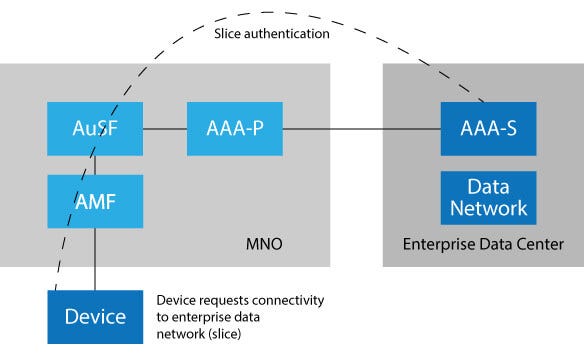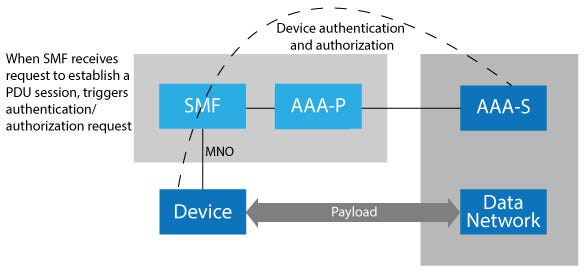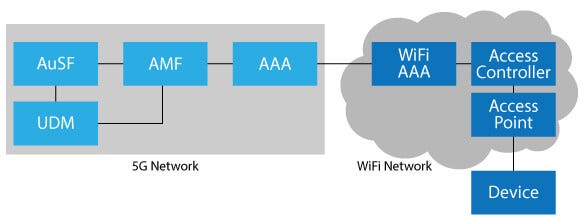Role of AAA in 5G and the IoT Ecosystem
Evolution of the Mobile Network
According to a report from the GSMA, the number of fifth-generation (5G) users worldwide is expected to reach 1.4 billion by 2025, which is 15 percent of the global total. 5G means a significant upgrade from the last generation of mobile networks. With its higher bandwidth, low-latency, and virtualization capabilities, it has unleashed a massive IoT ecosystem, and this is expected to rapidly boost the number of devices and users on the data network, making proper IT planning imperative. As the mobile network evolves, the AAA will play a key role in acting as a bridge between devices and networks, ensuring operators are able to maximize ROI on their 5G investment.
AAA Evolution
AAA is an important service and policy control framework, enabling CSPs to control how their subscribers access and consume data services over WiFi, FTTx, 5G, and other IP-based broadband networks. It touches a number of areas within the core network and back office, from security and provisioning to billing and, most significantly, customer experience.
Over a decade ago, the core functions of AAA were in line with dialup and, later on, DSL internet networks. Today, the ever-increasing need for improving customer experience, along with rapid growth in subscriber numbers and data usage, has placed new demands on AAA functionalities.
Diameter — the next-gen industry-standard protocol used to exchange authentication, authorization, and accounting information in LTE and IP Multimedia Systems (IMS) networks — provides a generic framework for exchanging AAA messages and defines a standard set of AAA request-and-response commands and attributes. Having evolved from RADIUS, it provides more reliable, secure, and flexible transport mechanisms for mobile data networks. It is used by LTE and IMS network functions, including the Policy and Charging Rules Function (PCRF), Home Subscriber Server (HSS), and Online Charging System (OCS) elements.
In modern networks where CSPs deliver services across multiple access networks such as fixed-mobile convergence (WiFi and mobile), the broadband network requires seamless user experience while accessing services. Within broadband networks, CSPs may have multiple types of network elements acting as service delivery points and policy enforcement points. In wireless networks such as 5G, the technology goal is to expand service capabilities in various industries using high-speed mobile broadband, Internet of Things (IoT), and virtualization by embracing key technologies like RESTful APIs. This ensures optimum performance, stateless and secured network functions (NFs), and a high level of quality of service (QoS) in the 5G Service Based Architecture (SBA).
The 5G SBA’s modular framework comprises components such as AuSF (Authentication Server Function), NEF (Network Exposure Function), NRF (NF Repository Function), PCF (Policy Control Function), NSSF (Network Slice Selection Function), and UDM (Unified Data Management), allowing deployment of diverse network services and applications. A robust AAA (like Alepo’s) facilitates seamless authentication for 5G network services, including authenticating and authorizing device access:
- To enterprise slices by integrating with an enterprise AAA server
- From non-3GPP networks such as WiFi and broadband
Download Our latest Resource: Designing a Seamless Migration Strategy for Network Operators
Top Ways AAA Can Help Telcos
Secure Access Control
The AAA server manages user profiles, holds access credentials, device identifiers, access policies, and so on. This helps enable various access control mechanisms such as barring access for blacklisted devices, allowing limited or walled-garden access. AAA helps implement corporate access control, allowing specific devices to offer connectivity to corporate network resources.
Revenue via Service Differentiation
AAA helps manage access profiles, data caps, time limits, and more, helping launch different bandwidth plans and implement data caps that are integral to driving revenue in broadband networks. Real-time usage monitoring helps control revenue leaks.
M2M/IoT Connectivity Management
Serving an important role in managing device connectivity for M2M or IoT networks, AAA holds device-specific network parameters that allow access to a specific enterprise network. It collects usage or event details from the network and helps identify device cell location and device online status, handles usage alerts, and pushes CDRs to the billing system to charge network usage.
Enhance Customer Experience
AAA helps push changes in service parameters and policies to different subscribers without disconnecting or resetting their connections. Operators can offer better customer experience through seamless session updates whenever a customer:
- Purchases a turbo boost bandwidth speed
- Surpasses their fair usage policies
- Refills balance for a prepaid account
Monitor Usage and Notifications
While monitoring usage and notifications, AAA supports enforcement of fair usage policies on reaching the defined time- and volume-based cap. It also helps standardize customer experience based on usage levels.
Monetize WiFi Access
AAA assists businesses to unlock a new revenue stream using the WiFi hotspot business model. The AAA server helps:
- Access time- and data-based passes
- Enable location-based services and offers
- Allow dynamic redirection to customized captive portals
Role of AAA in 5G-IoT Ecosystem
Authenticating Slice Access
5G and network slicing are often concurrently used, though network slicing is an architectural component that helps operators design and customize different slices that run on a common physical interface. Network slicing supports a multitude of use cases and new services through 5G and also establishes multi-vendor and multi-tenant network models using shared infrastructure. According to ABI Research, network slicing creates approximately US $66 billion additional value for telecom companies.
When a device requests connectivity for a specific slice, besides 5G network authentication, the enterprise or tenant may also want to authenticate the device. This is handled by AAA, which holds the profiles of devices that can connect to the enterprise slice.

Authorizing Data Connectivity
As a device attempts to connect an enterprise data network, such as a mobile device that accesses streaming services, or a drone camera trying to upload images to the data center, the enterprise or tenant may want to check the device requesting connectivity and restrict access to the network resource to certain devices. AAA authenticates the device, checks whether it is authorized to access the resource, and then provides the connection parameters such as IP address and QoS for data connectivity.

Multi-Service Access
Enterprise AAA plays a key role in connecting and authenticating devices to an enterprise network (slice), authorizing connectivity from non-LTE/5G networks such as WiFi and broadband. When the device tries to connect to 5G networks from non-LTE/5G networks such as WiFi, broadband, AAA plays an important role in authenticating the device, authorizing connectivity to the 5G core network function to allow seamless connectivity for mobile devices from non-5G networks.

Smart City
5G rollout will not only deliver high-speed connectivity globally but will facilitate the ability to handle massive network connections and unlock new life-enhancing services. Smart cities will integrate devices over 5G networks to build an intelligent city with smart traffic, smart homes, parking, waste management, public safety, and smart utility facilities. Coupled with enterprise IoT, AI, AR, and VR, 5G will offer maximum potential for service innovations in building smart cities, including use cases (slices) such as healthcare, drone, education, energy, and more. Additionally, use cases like connected vehicles, high streaming voice, and video transmission from crime sites, air pollution monitoring, and surgeries using AR and VR will further enhance lives.
Entertainment and Gaming
In both the entertainment and gaming fields, IoT solutions have played a major role in helping track emerging trends and consumer tastes in entertainment and giving users highly immersive gaming experiences. IoT caters to the entertainment industry’s three major needs: strong knowledge of the latest trends and user preferences, creating immersive content, and targeted ad campaigns. Today, users enjoy a whole new level of user-engaging visual content and gaming procedures with features such as:
- Visible texts in the screenplay of video games
- High-level 3D and reporting models
- Content productions via AR and VR approach
Smart Home and Smart Building
IoT, combined with 5G-enabled tools and technologies, brings more control and efficiency to intelligent buildings and at home. These tools help control the connected home, comprising appliances, lighting, entertainment, safety, security, HVAC, temperature, energy management, and more from smart devices like smartphones, tablets, or laptops over the WiFi network. Smart home solutions leverage connected and automated homes by enabling users to centrally manage all devices from one location and provide device-specific instructions at just one click. IoT-enabled or smart buildings with AI-driven analytics help restructure key aspects of commercial buildings: construction, habitation, and maintenance enhancing the quality of life of occupants and staff. Building automation 2.0 covers smart building solutions covering space management, asset management, cleanliness and hygiene management, and environmental monitoring.
Smart Manufacturing
5G gives manufacturers and telecom operators the greatest opportunity to collaborate and build smart manufacturing units. By truly exploiting automation, artificial intelligence, and industrial IoT (IIoT), manufacturers can change the game of their business and discover innovative ways to adopt industry 4.0 practices. 5G RAN, network slicing, cloud infrastructure, and real-time data collection through AI build a strong vision of fully connected and automated factories. Having broader access to greater amounts of data, this use case revolutionizes the production capabilities of the manufacturing units by enabling manufacturers to generate meaningful data, which can be further used to enhance digitalization, create new revenue streams, identify operational obstacles, optimize industrial processes, and save manufacturing costs. Smart manufacturing has the maximum scope to transform businesses with complex device communications and stringent, costly, time-consuming manual processes.
Steps To Create A Winning Deployment
Virtualization
Virtualization plays an important role in any product deployment as it helps automate product delivery by using the latest NFV technologies. It helps enhance performance as it monitors network resources and can scale and heal automatically. Virtualizing the core network can also bring the benefit of network slicing and customized use cases such as smart cities, autonomous vehicles, entertainment, gaming, and remote healthcare. This helps build networks that boost performance, capacity, latency, security, reliability, and coverage of the application developed.
Open Standards
Standardization like 3GPP and REST APIs are the foundation on which different products and services are developed. They bridge the gap between work processes and deliverables to ensure performance and interoperability across the mobile supply chain. This helps eliminate vendor lock-in as it is always possible to get another vendor to deploy a solution that meets industry standards.
AAA Transformation
AAA Transformation helps CSPs streamline processes and reduce all of their ownership costs. With support for all access technologies, it equips them with a single platform to deliver AAA needs across broadband, mobile, WiFi, and M2M/IoT segments. Operators can boost performance and security by integrating multivendor legacy AAA deployments into a centralized cloud environment.
Download the whitepaper: AAA Transformation
Digital BSS
A digital BSS stack helps CSPs deliver digital-first customer experience and automate business processes in both 5G and IoT deployments by upgrading their legacy BSS with a new 5G-ready stack. A modular BSS delivers a complete digital transformation that helps greenfield operators with full-stack deployment and replaces legacy systems that operate in a phased approach.
Conclusion
A high-performance and robust AAA Server integrated with 5G and IoT networks can be used for multiple use cases across various industrial sectors. It helps provide cost-saving network optimizations for end-to-end business processes. Advanced virtualized AAA solutions, combined with system integrations and data migration solutions, will deploy market-leading and cost-efficient services without affecting the current system or customer experience.
Source: Alepo Blog






Comments
Post a Comment